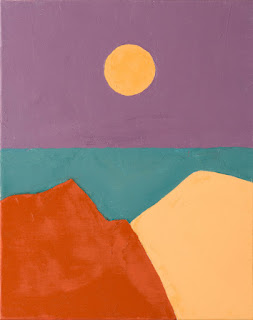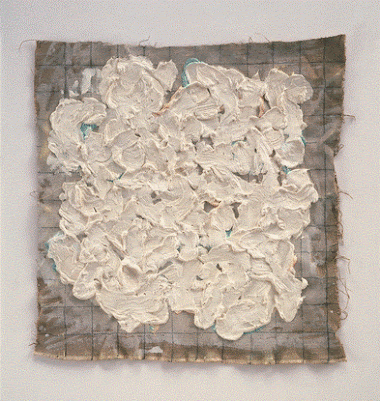Impasto
Introduction
There was a time when painters didn't want to show brush marks. They applied paint in thin layers, even to the point, near the end, applying thin transparent subtle layers of color called glazes.
Vincent Van Gogh applied paint in the opposite fashion. One of his self portraits shows him holding a palette in his left hand together with a handful of same size somewhat small brushes. As you look at the painting take into account the image reversal caused by the mirror he was using. Each brush carried and stroked just one color from his palette — an efficient method fitting his style.
A Van Gogh painting seen up close, looks like plowed furrows and dabs of color next to each other. His brushwork and whole presentation, though recognizable from nature, has an abstracted and consistently world-unto-itself character.
Smooth Abstraction
In contrast to our subject of impasto, many geometrical abstract paintings are deliberately smooth. They are meant to be non gestural, in order to revolt and distance themselves from abstract expressionism (gestural, expressive, dripping and flinging of paint) which was influential in the 1950s. Key artists in the movement to smoothness were Ellsworth Kelly, Josef Albers, and Leon Polk Smith. In fact, Smith said he wanted his painted surface to “look like a wall”.
Texture
Before we get started: how does texture compare to impasto?
The look of texture can be achieved with or without a raised surface. It uses small marks in a region. It is repetitious but needn't be uniform. Some physical examples are corduroy fabric, beach sand, and tree bark. For an example of texture in art, recall our post about Roy Lichtenstein. He used textural hatching and dots and a kind of hand made woodgrain effect. You can see or review all those quickly by using the name Lichtenstein in the blog search box, then scroll down to the images.
An Impasto Portrait
Can impasto in the form of palette knife painting succeed in portraiture? Perhaps surprisingly, yes.
We present a painting, called Woman in Blue from 1943, by the black American artist William H. Johnson. He is included in the current exhibition of Spring 2024 at the Metropolitan Museum of Art in New York City. The exhibition title is: The Harlem Renaissance and Transatlantic Modernism.
The above image is presented overly large to allow you to see the palette knife marks throughout -- even in the eyes. After that, back away to get the general intended effect. Palette knife work, to me, gives a sense of decisiveness and no weakness in the paint film.
The Met chose this painting as their lead publicity image for the exhibition. By your observation, can you explain the artfulness and attraction of the painting?
Consider the background, the woman's dress, her position in, on, or next to the chair, is there a problem?, any other oddities?, lower lip? do those irregularities matter?, were they intended?, do they contribute something?, note colors, shapes, hands, as well as mood or emotion visible in the face. How conveyed? How is this work different from other portraits you have seen? Any shadows? What do you think Modernism means in the Exhibition title?
Impasto Abstraction
Etel Adnan
The Lebanese - American woman, poet and artist Etel Adnan made simple yet effective abstract landscapes . She used a palette knife which looks like a small trowel and leaves troweling marks. If you enlarge the images you may be able to see the marks. Actually, this is a very good case for seeing the actual painting in a gallery where you can look from the side to see raised areas. Later we will see some obviously heavy impasto paintings.
This first painting works wonderfully well with a more lively new range of "landscape" colors. The orange "sun" seems to just hang there against the light gray sky. For me, it has a magic effect.
Before we continue: some words from the artists themselves.
I don’t know if you’ll understand
that you can speak poetry
just by arranging colors. Vincent Van Gogh
We are not playing a game of sorrow
we are trying to grow wings and fly. Etel Adnan
This next painting shows a toned down purple against a beige standing-in-for-yellow. That produces a complementary color effect between the sky and the moon or sun object.
Many of Adnan's works are untitled, but we can think of
this next painting as of the American West.
To see Adnan's palette knife process carried out in detail, view (search for) the YouTube video called Paint Like Etel Adnan. It is one of the videos of a series on artists and their art making methods. The series is called Imperfect Paintings. By further YouTube searching using Adnan's name, you can find revealing interviews with her. She has a wonderfully sincere and joyful presence.
Robert Ryman
Robert Ryman is known for his white paintings. He said “it is not a question of what to paint but how to paint”. Earlier in his life he was a promising jazz saxophone player but he switched to painting.
It is claimed that he brought over some of the jazz esthetic.
Namely, in musical performance you play one note at a time and can't change it. So, in painting he wanted to make one deliberate stroke at a time, not make changes or corrections, and see the succession of strokes through to the end.
Much the same idea prevails in plein air painting, done outdoors, and ala prima painting, done in one session. The idea common to both is to use limited time effectively, with no time to fuss or make corrections. Van Gogh, much admired by Ryman, painted out doors and in one session. Cezanne also was known for deliberate and considered paint strokes.
So, Ryman's painting is considered, deliberate, and abstruse. His picture making was about the look of paint on a particular substrate, in a certain arrangement, and under fixed or changing lighting. With that in mind, look at an early work of his. You can't miss the impasto this time.
Notice the substrate has a color and looks rather flexible and fragile. In contrast, many of Ryman’s later works are on sturdy aluminum plates. One can't help thinking of spreading peanut butter, or still better cream cheese, on toast. That image, not thought of as a criticism, but seen in a positive way, brings you to appreciate beauty in everyday life if you look for it.
See also a later more subtle work.
Ryman and his quiet contemplative esthetic found respect and a following. His work is displayed in most major museums. Notice I said displayed because museums hold many worthy works that they don't display, especially works on paper.
Previous examples in the Blog
We have already seen in previous posts impasto paintings by other artists but didn't call attention to the impasto character. The artists are McArthur Binion, who worked with oil paint sticks and Jules Olitski who used painter's mitts. To review and compare them, use the blog search bar. Just the last name as search key works fine.
Daisuke Takahashi
Now we present Daisuke Takahashi, a contemporary Japanese painter who uses surprisingly high impasto. He was born in 1980. His paintings shown below are roughly 2 by 3 feet or less.
I suspect a certain playfulness as seen below with the orange impasto "frame".
Please look below. The boat and background are broken up with impasto breakaways. It gives the impression of an outdoor poster that is weathered and peeling. And the bottom band seems to suggest that the boat emerged from a more abstract or random start. Is this a kind of joke or speeded up evolution? Or some intended disjoint?
This next Takahashi painting below is not impasto. It is named Ashan and claims to be inspired by the appearance of a person the artist happened to meet at a convenience store. For this work, I would like to grope for an interpretation and you are welcome to also.
Allowing playfulness, the left figure could be wearing a slouch hat and a generous cape. The right figure could be a tree or a woman. In any case, the figures seem to be looking at and communicating with each other.
Or appropriately, the figures seem like Chinese characters made using a brush with a certain flourish and tradition of brush holding and usage. Those practices are surely known and respected in Japan. Actually Kanji, one of the three Japanese scripts, uses Chinese characters.
An Aside
Permit me now something further afield but still related. You may find it of interest. The subject person is Japanese. His performance (skill or even art?) is striking and truly exceptional.
The contemporary Japanese boxer named Naoya Inoue is in the bantamweight category --- not known for power and knockouts. But, Inoue has a knockout percentage of 90.4% in world title matches. That is superior to Mike Tyson and way higher than Mohammed Ali.
Inoue holds the world boxing title in four weight classes, defeating boxers in higher weight classes than his own. You can see him in action on YouTube artfully dispatching many worthy opponents. His knockouts are impressively clean without mauling.











ReplyDeleteThis blog beautifully explains the essence of abstract painting. It’s not just art, but an expression that transforms any wall into a masterpiece. For anyone planning to buy abstract paintings online, I highly recommend Vibecrafts. Their collection is full of premium-quality, creative, and affordable artworks that suit modern living spaces perfectly.